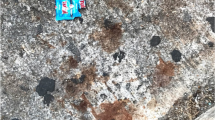Abstract
Betel nut (BN) is a psychoactive oral carcinogen that is commonly used among Asian communities. This study aims to investigate BN usage patterns and the effectiveness of a visually guided educational initiative in a high-risk refugee population. All adult patients presenting to a private practice clinic, free community clinic, or health fair in the refugee community of Clarkston, Georgia during days when survey staff were present were approached for the study. Participants were first categorized into a familiar and unfamiliar cohort depending on participant-reported familiarity with BN. Depending on familiarity, subjects were then administered a pre-intervention test surveying health awareness for BN and usage patterns where relevant; subsequently, a visually guided educational brochure was reviewed, and a post-intervention test was administered. Results were statistically analyzed (STATA 12). Forty-eight participants were surveyed for the familiar cohort and 25 for the unfamiliar cohort. Among the familiar cohort, South and Southeast Asians comprised 91% of participants. On frequency of use, 42.8% reported social, 28.6% reported usage during celebrations only, and 28.6% reported daily. The most common reasons for use were for taste (40.9%), enjoyment (38.6%), and addiction (25%). Among the familiar cohort, 75% believed BN was harmful for health compared to 8% among the unfamiliar (p < 0.0001). In the familiar cohort, 52.3% believed BN alone could cause cancer compared to 4% among the unfamiliar (p < 0.0001). Following the educational intervention, 100% of participants believed BN mastication is harmful in both cohorts (p < 0.01), while 87.5% of participants in both cohorts recognized that BN alone could cause cancer (p < 0.0007). This study illustrates gaps in understanding regarding oral cancer and the health consequences of chronic BN mastication, as well as the efficacy of a visually guided educational brochure to improve participant knowledge among a high-risk refugee population



Similar content being viewed by others
References
Gupta PC, Warnakulasuriya S (2002) Global epidemiology of areca nut usage. Addict Biol 7(1):77–83. https://doi.org/10.1080/13556210020091437
Frankie AA, Lai JF, Kawamoto CT, Pokhrel P, Herzog TA (2014) Areca (betel) nut consumption: an underappreciated cause of cancer. Hawaii J Med Public Health 73(12):400–403
Pickwell SM, Schimelpfening S, Palinkas LA (1994) Betelmania: betel quid chewing by Cambodian women in the United States and its potential health effects. West J Med 160(4):326–330
Furber S, Jackson J, Johnson K, Sukara R, Franco LA (2013) Qualitative study on tobacco smoking and betel quid use among Burmese refugees in Australia. J Immigr Minor Health 15(6):1133–1136. https://doi.org/10.1007/s10903-013-9881-x
Anand R (2014) Betel nut chewing and its deleterious effects on oral cavity. J Cancer Res Ther 10(3):499–505. https://doi.org/10.4103/0973-1482.137958
Sessions DG, Spector GJ, Lenox J, Haughey B, Chao C, Marks J (2002) Analysis of treatment results for oral tongue cancer. Laryngoscope 112(4):616–625. https://doi.org/10.1097/00005537-200204000-00005
Group IW (2004) Betel-quid and areca-nut chewing and some areca-nut-derived nitrosamines. Vol 85. IARC Press, Lyon
Khawaja MR, Mazahir S, Majeed A, Malik F, Merchant KA, Maqsood M, Malik R, Ghaffar S, Fatmi Z (2006) Chewing of betel, areca, and tobacco: perceptions and knowledge regarding their role in head and neck cancers in an urban squatter settlement in Pakistan. Asian Pac J Cancer Prev 7(1):95–100
Nelson-Peterman JL, Toof R, Liang SL, Grigg-Saito DC (2015) Long-term refugee health: health behaviors and outcomes of Cambodian refugee and immigrant women. Health Educ Behav 42(6):814–823. https://doi.org/10.1177/1090198115590779
Guggenheimer JV, R. S.; Johnson, J. T.; Horkowitz, C. A.; Myers, E. N. Factors delaying the diagnosis of oral and Oropharyngeal carcinomas. Cancer 1989;64(4):932–935, https://doi.org/10.1002/1097-0142(19890815)64:4<932::AID-CNCR2820640428>3.0.CO;2-Y
Stefanuto P, Doucet JC, Robertson C (2014) Delays in treatment of oral cancer: a review of the current literature. Oral Surg Oral Med Oral Pathol Oral Radiol 117(4):424–429. https://doi.org/10.1016/j.oooo.2013.12.407
Aziz SR (2010) Coming to America: betel nut and oral submucous fibrosis. J Am Dent Assoc (1939) 141(4):423–428. https://doi.org/10.14219/jada.archive.2010.0194
Devine BP (2012) Are you ready for the betel nut? Texas Dent J 129(8):767–769
Changrani J, Gany F (2005) Paan and Gutka in the United States: an emerging threat. J Immigr Health 7(2):103–108. https://doi.org/10.1007/s10903-005-2643-7
The Rise of Asian Americans. 2012; http://www.pewsocialtrends.org/2012/06/19/the-rise-of-asian-americans. Accessed April 22, 2017
Nathan KA (2010) Areca cessation and dentists in harrow (North London). Prim Dent Care 17(1):38–42. https://doi.org/10.1308/135576110790307609
Blank M, Deshpande L, Balster RL (2008) Availibility and characteristics of betel products in the US. J Psychoactive Drugs 40(3):309–313. https://doi.org/10.1080/02791072.2008.10400646
Tareg AR, Modeste NN, Lee JW, Santos HD (2015) Health beliefs about tobacco with betel nut use among adults in Yap, Micronesia. Int Q Community Health Educ 35(3):245–257. https://doi.org/10.1177/0272684X15581344
Funding
This project was partially funded through a SIGnature Grant from the Urban Health Initiative (UHI) at Emory University. The UHI serves to provide health disparities education and build collaborative partnerships with underserved communities in Atlanta, GA. It was also partially funded through the 2017 Head & Neck Cancer Alliance (HNCA)/American Head & Neck Society (AHNS) International Outreach Cancer Prevention Grant.
Author information
Authors and Affiliations
Corresponding author
Ethics declarations
Conflict of Interest
The authors declare that they have no conflict of interests.
Rights and permissions
About this article
Cite this article
Shi, L.L., Bradford, E., Depalo, D.E. et al. Betel Quid Use and Oral Cancer in a High-Risk Refugee Community in the USA: The Effectiveness of an Awareness Initiative. J Canc Educ 34, 309–314 (2019). https://doi.org/10.1007/s13187-017-1303-7
Published:
Issue Date:
DOI: https://doi.org/10.1007/s13187-017-1303-7




